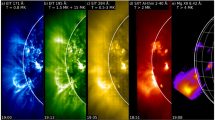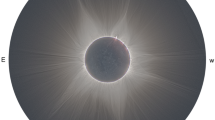Abstract
The results of a study of a polar coronal hole based on data from observations of the solar eclipse of March 29, 2006, with the RATAN-600 radio telescope in a wide centimeter wavelength range of λ = (1.03, 1.38, 2.7, 6.2, 13.0, 30.7) cm are analyzed. The circumstances of the eclipse and the method used to process the observational data are briefly described. The distributions of the brightness temperatures in a polar coronal hole of the Sun from the limb of the solar optical disk to distances equal to its two radii are discussed. A sharp decrease in the intensity of radio emission of the polar coronal hole at wavelengths λ ≥ 6 cm near the solar limb was detected. The absence of the detection of a polar coronal hole at λ = (1.03, 1.38, 2.7) cm wavelengths is studied based on data from earlier observations by the BPR and RATAN-600 radio telescopes of the quiet Sun. The similarity of the temperature properties of polar and low-latitude coronal holes discovered in the radio range is discussed. The discussion provides an overview of some results of the study of a solar polar coronal hole based on observations with the radio telescopes BPR, RATAN-600, and RT-22 (Crimean Astrophysics Observatory), the Nobeyama radioheliograph, and other radio telescopes based on (EUV SOHO/EIT) data and data from theoretical works.







Similar content being viewed by others
REFERENCES
Abramenko, V.I., Fisk, L.A., and Yurchyshyn, V.B., The rate of emergence of magnetic dipoles in coronal holes and adjacent quiet-Sun regions, Astrophys. J., 2006, vol. 641, pp. L65–L68.
Babin, A.N., Gopasyuk, S., Efanov, V.A., et al., Enhancement of magnetic fields, radio brightness at mm-wavelengths and H-alpha activity at the polar regions of the Sun, Izv. Krym. Astrofiz. Obs., 1976, vol. 55, pp. 3–13.
Borovik, V.N., Kurbanov, M.S., Livshits, M.A., and Ryabov, B.I., Coronal holes on the background of the quiet Sun: Analysis of RATAN-600 observations in the 2–32-cm range, Sov. Astron., 1990, vol. 34, pp. 522–534.
Cranmer, S.R., Coronal holes, Living Rev. Sol. Phys., 2009, vol. 6, no. 1, pp. 3–66.
Dulk, G.A. and Sheridan, K.V., The structure of the middle corona from observations at 80 and 60 MHz, Sol. Phys., 1974, vol. 36, pp. 191–202.
Fisk, L.A. and Schwadron, N.A., The behavior of the open magnetic field of the Sun, Astrophys. J., 2001, vol. 560, pp. 425–438.
Golubchina, O.A., Manifestation of the identity of brightness temperatures of the polar coronal hole and low-latitude coronal holes in the centimeter wave range, Geomagn. Aeron. (Engl. Transl.), 2017, vol. 57, no. 8, pp. 964–967.
Golubchina, O.A. and Golubchin, G.S., The relay race method, Izv. Spets. Astrofiz. Obs., Astrofiz. Issled., 1981, vol. 14, pp. 125–131.
Golubchina, O.A. and Korzhavin, A.N., Distribution of centimeter-wave brightness temperature of solar polar region, Astrophys. Bull., 2013, vol. 68, no. 2, pp. 219–225.
Golubchina, O.A., Korzhavin, A.N., and Tokhchukova, S., Brightness temperature distribution in solar corona based on RATAN-600 observations of the maximum phase of the March 29, 2006 solar eclipse, Astrophys. Bull., 2011, vol. 66, no. 4, pp. 488–495.
Gopalswamy, N., Shibasaki, K., Thompson, J., and DeForest, C., Microwave enhancement and variability in the elephant’s trunk coronal hole: Comparison with SOHO observations, J. Geophys. Res., 1999, vol. 104, no. A5, pp. 9767–9779.
Harvey, J., Krieger, A.S., Davis, J.M., Timothy, A.F., and Vaiana, G.S., Comparison of Skylab X-ray and ground-based Helium observations, Bull. Am. Astron. Soc., 1975, vol. 7, p. 358.
Kosugi, T., Ishiguro, M., and Shibasaki, R., Polar-cap and coronal-hole-associated brightenings of the Sun at millimeter wavelengths, Publ. Astron. Soc. Jpn., 1986, vol. 38, pp. 1–11.
Lantos, P. and Avignon, Y., The metric quiet sun during two cycles of activity and the nature of the coronal holes, Astron. Astrophys., 1975, vol. 41, pp. 137–142.
Munro, R.H. and Jackson, B.V., Physical properties of a polar coronal hole from 2 to 5 Rs, Astrophys. J., 1977, vol. 213, pp. 874–886.
Munro, R. and Withbroe, G., Properties of a coronal “hole” derived from extreme-ultraviolet observations, Astrophys. J., 1972, vol. 176, pp. 511–520.
Obridko, V.N. and Solov’ev, A.A., Magnetohydrostatic model for a coronal hole, Astron. Rep., 2011, vol. 55, no. 12, pp. 1144–1154.
Oliveira e Silva, A.J., Selhorst, C.L., Simões, P.J.A., and Giménez de Castro, C.G., Comparison of solar radio and extreme ultraviolet synoptic limb charts during the present solar maximum, Astron. Astrophys., 2016, vol. 592, p. A91.
Pasachoff, J.M., Rušin, V., Druckmüller, M., and Saniga, M., Fine structures in the white-light solar corona at the 2006 eclipse, Astrophys. J., 2007, vol. 665, pp. 824–829.
Pohjolainen, S., On the origin of polar radio brightenings at short millimeter wavelengths, Astron. Astrophys., 2000, vol. 361, pp. 349–358.
Riehokainen, A., Urpo, S., Valtaoja, E., et al., Millimeter-radio, SOHO/EIT 171 Å features and the polar faculae in the polar zones of the Sun, Astron. Astrophys., 2001, vol. 366, pp. 676–685.
Selhorst, C.L., Silva, A.V.R., Costa, J.E.R., and Shibasaki, K., Temporal and angular variation of the solar limb brightening at 17 GHz, Astron. Astrophys., 2003, vol. 401, pp. 1143–1150.
Selhorst, C.L., Silva, A.V.R., and Costa, J.E.R., Solar atmospheric model with spicules applied to radio observation, Astron. Astrophys., 2005, vol. 440, pp. 367–371.
Selhorst, C.L., Giménez de Castro C., Varela Saraiva, A.C., and Costa, J.E.R., How are the EUV and radio polar limb-brightenings correlated?, Astron. Astrophys., 2010, vol. 509, p. A51.
Shibasaki, K., Long-term global solar activity observed by the Nobeyama radioheliograph, Publ. Astron. Soc. Jpn., 2013, vol. 65, p. 17.
Shibasaki, K., Alissandrakis, C.E., and Pohjolainen, S., Radio emission of the quiet Sun and active regions, Sol. Phys., 2011, vol. 273, pp. 309–337.
Shimabukuro, F.L., Wilson, W.J., Mori, T.T., and Smith, P.L., 3.3 millimeter limb brightening measurements during the 30 June 1973 total solar eclipse, Sol. Phys., 1975, vol. 40, pp. 359–370.
Sobolev, V.V., Kurs teoreticheskoi astrofiziki (Course in Theoretical Astrophysics), Moscow: Nauka, 1967.
Waldmeier, M., Synoptische Karten der Sonnenkorona, Z. Astrophys., 1956, vol. 38, pp. 219–236.
Wang, Y.M., Biersteker, J.B., Sheeley, N.R., et al., The solar eclipse of 2006 and the origin of raylike features in the white-light, Astrophys. J., 2007, vol. 660, pp. 882–892.
Withbroe, G. and Wang, Y., A model for the polar transition layer and corona for November 1967, Sol. Phys., 1972, vol. 27, pp. 394–401.
Zheleznyakov, V.V., Radioizluchenie Solntsa i planet (Radio Emission of the Sun and Planets), Moscow: Nauka, 1964.
ACKNOWLEDGMENTS
The author thanks the RATAN-600 group of radio engineers who ensured successful observations on precision radio equipment: N.A. Nizhelsky, G.N. Zhekanisu, P.G. Tsybulev, and N.N. Bursov.
Funding
The work was carried out within the framework of the state assignment of the Special Astrophysical Observatory of the Russian Academy of Sciences in the section “Conducting Basic Scientific Research.”
Author information
Authors and Affiliations
Corresponding author
Rights and permissions
About this article
Cite this article
Golubchina, O.A. Analysis of the Physical Characteristics of the Polar Coronal Hole on the Sun in the Microwave Wavelength Range. Geomagn. Aeron. 61 (Suppl 1), S9–S15 (2021). https://doi.org/10.1134/S0016793222010091
Received:
Revised:
Accepted:
Published:
Issue Date:
DOI: https://doi.org/10.1134/S0016793222010091




